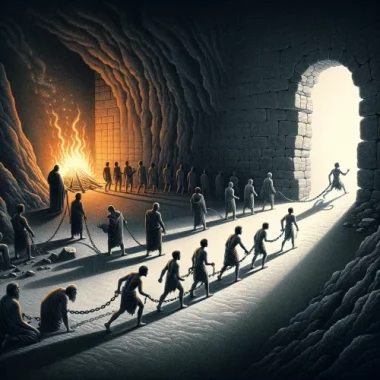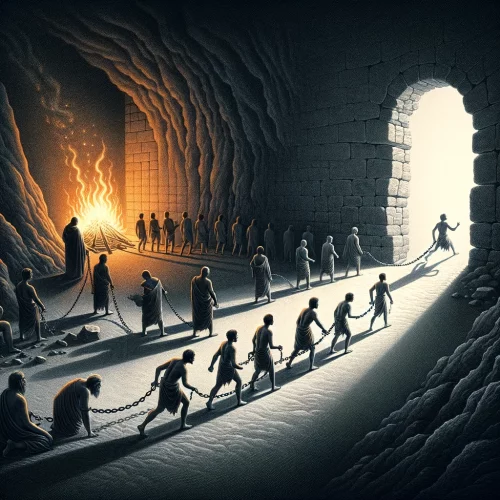
Plato’s Allegory of the Cave
Introduction
Imagine living in a dark place where everything you see is just a shadow, and your whole life you believe these shadows are the only real things. Well, this picture is part of a famous story called Plato’s Allegory of the Cave. It’s a story that Plato, a great thinker from ancient Greece, wrote to help us understand the difference between what seems real to us and what is actually real. It’s not just a puzzle about truth, but it’s a kind of riddle that makes us think hard about what we know and what we don’t know.
Plato’s Allegory of the Cave comes from his writing called “The Republic,” which shows us how easily we can be fooled by fake things and how surprising the truth can be when we first learn about it. So, let’s explore this allegory, which isn’t just a story, but a deep lesson about life and the search for truth.
Definitions of the Topic
First Definition: Plato’s Allegory of the Cave is a symbolic story about people who are trapped inside a dark cave. These people have been there since they were born and are tied up so they can only look at the cave wall in front of them. Behind them is a fire, and between the fire and the prisoners, there are people holding up objects that cast shadows on the wall. The prisoners think these shadows are all that is real because they never saw the actual objects or the world outside the cave.
Second Definition: The allegory is also about what happens when one prisoner gets free and sees the real world for the first time. At first, it’s overwhelming and hard for him to understand, but as his eyes get used to the light, he starts to see how the shadows in the cave were just copies of the real things outside. When he goes back to the cave to tell the others, they don’t believe him. This part of the story shows us what it’s like to discover deeper truths about life and how tough it can be when others don’t understand or accept these truths.
Key Arguments
- Perception is not reality: What we think we see and understand isn’t necessarily the truth. It might just be a shadow or an impression of the real thing, like the shadows on the cave wall are not real objects.
- Ignorance blinds us: If you haven’t had a chance to learn or see something different, you don’t know what you’re missing. The prisoners in the cave don’t know there’s more to see because they’ve never seen the outside world.
- Education is enlightening: Learning about new things can be like moving from a dark place into the light, where you can see everything more clearly. This is like the prisoner who escapes and learns about the real world.
- Resistance to enlightenment: Sometimes when people learn new things that are different from what they always believed, they don’t want to accept it. This is like the prisoners who don’t believe the freed prisoner when he comes back to tell them about the outside world.
- Responsibility to educate: When someone learns the truth, it’s like they have a job to teach others, even if it’s difficult or if people make fun of them. The freed prisoner felt that he had to go back and tell the others what he saw, even though they didn’t listen.
Answer or Resolution
Plato’s Allegory of the Cave isn’t about giving us a clear answer to a problem. Instead, it’s a way to make us think and question. The story ends with us thinking about our own journey to learn and become better. It’s about moving from what we know now, which might not be complete or true, to somewhere brighter where we understand more about ourselves and the world.
Major Criticism
Not everyone agrees with what the Allegory of the Cave tries to say. Some people think it tells us that only a few can really know the truth, which seems unfair. Others don’t believe there is just one true reality to find. And some people argue that it’s not enough to just think about big ideas; we also need to know things that help us in our everyday life, like science and practical skills.
Why It’s Important
This allegory is important because it helps us understand that it’s easy to accept simple answers and not look deeper. Realizing that there’s more to learn, even if it’s tough, is a huge part of growing and becoming wiser. It’s like having a map that shows there’s more beyond what we know.
For anyone, no matter their age, the allegory teaches a valuable lesson about being open-minded and always looking to learn. Instead of just taking things as they are, it encourages us to ask questions, seek the truth, and not be afraid to change our minds when we find new information. The cave is a symbolic place where we might be stuck, but learning and questioning can be the light that leads us out to a bigger and brighter world.
Practical Applications
- Education: The allegory tells teachers and students that learning isn’t just about memorizing facts. It’s about thinking deeply and understanding big ideas. This helps students become better at solving problems and making decisions.
- Psychology: It relates to how we grow and change in our thinking. As we have new experiences and learn more, our beliefs and thoughts can change, just like the prisoner’s did when he saw the outside world.
- Political Philosophy: It warns us to be careful about how leaders and governments might try to trick us by controlling what we see and hear. People need to think critically about what they’re told, especially when it comes to making decisions about their community or country.
- Media Studies: The allegory can explain how the media can present things in a way that isn’t always true to make people believe a certain point of view. This shows the need to look at different sources and think for ourselves instead of just believing everything we see on TV or online.
Plato’s Allegory of the Cave reminds us that there’s always a lot more to discover, about the world and about ourselves. It’s a story about what it means to really learn and understand, and it calls on us to never stop searching for what’s real and true.
Related Topics
- Epistemology: This is the study of knowledge, asking questions like “What is knowledge?” and “How do we know something is true?” It’s closely related to the allegory because Plato is showing us how hard it can be to really know the truth.
- Metaphysics: Metaphysics is all about the nature of reality. It tries to understand what exists beyond what we can see and touch. In the allegory, the idea that there is a truer reality outside the cave is a metaphysical idea.
- Socratic Method: Named after Socrates, Plato’s teacher, the Socratic Method is a way of exploring ideas by asking lots of questions. This method gets us to think and learn, much like the story of the cave encourages us to ask what’s really true.
- Symbolism: In literature and art, symbolism is using symbols to give deeper meaning to something. The cave, the shadows, and the journey outside are all symbols in Plato’s story, representing deeper ideas about life, truth, and knowledge.
Conclusion
So, what’s the big takeaway from Plato’s Allegory of the Cave? It’s a story about our journey to understand the world and ourselves. It shows us that what we think is real might be just shadows on a wall, and that the truth is often bigger and more complex than we could imagine. The allegory doesn’t just leave us thinking; it also calls us to act by being curious, learning more, and helping others to understand. It’s not just a philosophical puzzle; it’s a guide for life, encouraging us to step out of our own “caves” and explore the light of knowledge and truth.
